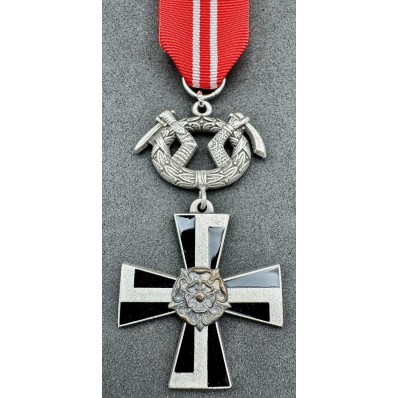Nessun prodotto
Prodotto aggiunto al tuo carrello
Ci sono 0 articoli nel tuo carrello. Il tuo carrello contiene un oggetto.
Ordine della Croce della Libertà 4a Classe 1941 - Finlandia
Novità
L'Ordine della croce della Libertà è un ordine cavalleresco della Repubblica di Finlandia.
L'Ordine venne fondato il 4 marzo 1918 su iniziativa del generale Mannerheim, comandante in capo all'esercito finlandese e governatore provvisorio dopo la fine della monarchia.
- L'ACCESSORIO DA NASTRO IN FOTO È INCLUSO -
- Soddisfatti o rimborsati: sicurezza garantita al 100% sul tuo ordine
- Reso gratuito: restituisci il tuo ordine gratuitamente entro 30 giorni dalla ricezione
- Pagamento sicuro: paga online in completa sicurezza con PayPal o carta di credito

Dettagli
Storia
L'Ordine della croce della Libertà di Finlandia venne fondato il 4 marzo 1918 su iniziativa del generale Mannerheim, comandante in capo all'esercito finlandese e governatore provvisorio dopo la fine della monarchia. La decorazione venne affidata nella sua creazione al rinomato artista finlandese Akseli Gallen-Kallela. Le prime decorazioni vennero concesse il 15 aprile 1918. L'Ordine, nel corso degli anni della Seconda guerra mondiale, a seguito da parte del governo di Mannerheim per necessità strategiche dell'alleanza con la Germania nazista, venne concesso largamente ad ufficiali di rilievo del Terzo Reich. Oggi le insegne dell'Ordine si trovano impresse nella bandiera personale del Presidente della Repubblica finlandese.
Classi
L'Ordine dispone dalla fondazione delle seguenti classi di benemerenza:
- Cavaliere di Gran Croce (medaglia smaltata, stella e fascia)
- Croce della Libertà di I classe (stella, nastro al collo, medaglia smaltata di bianco con svastica d'oro, rosa bianca)
- Croce della Libertà di II classe (medaglia da petto smaltata di bianco con svastica d'oro, rosa bianca)
- Croce della Libertà di III classe:
- Classe militare: medaglia da petto di ferro nero, svastica e rosa d'oro
- Classe civile: medaglia da petto smaltata di blu, svastica e rosa d'oro
- Croce della Libertà di IV classe:
- Classe militare: medaglia da petto di ferro nero, svastica e rosa d'argento
- Classe civile: medaglia da petto di ferro nero, svastica e rosa d'argento
- Medaglia della Libertà di I classe
- Medaglia al merito di I classe
- Medaglia della Libertà di II classe
- Medaglia al merito di II classe
Medaglie con Nastro
- Germania
- Medaglie, Ordini e Decorazioni
- Distintivi, Spille e Brevetti
- Piastrine di Riconoscimento
- Scudetti
- Cappelli
- Fregi da Cappello
- Fregi per Mostrine
- Mostrine, Spalline e Controspalline
- Fasce da Braccio
- Fascette da Polso
- Fibbie e Cinturoni
- Bottoni per Uniformi
- Timbri
- Gorgiere
- Anelli
- Anello d'Onore delle SS in Argento 925 - Set da Collezione
- Puntali
- Bandiere
- Daghe e Pugnali (Ornamentali)
- Bastoni da Feldmaresciallo
- Borse per Munizioni, Bandoliere e Tasche
- Orologi di Servizio
- Scatoline di Presentazione
- Documenti e Lettere di Assegnazione
- Busti, Aquile, Accendini e Varie
- Militaria Croata e degli Ustascia
- Articoli Denazificati
- Collane Commemorative
- Ricambi, Minuterie ed Accessori
- Italia
- Medaglie e Decorazioni
- Distintivi, Spille e Brevetti
- Scudetti e Placche
- Gorgiere
- Cappelli
- Fregi da Cappello
- Fregi per Mostrine
- Mostrine, Spalline e Controspalline
- Fibbie
- Cinturoni
- Bottoni
- Anelli
- Puntali
- Resistenza Italiana
- Portachiavi
- Crest
- Daghe
- Bandiere
- Busti e Aquile
- Gadget e Oggettistica
- Collane Commemorative
- Germania Imperiale
- Unione Sovietica
- Altre Nazioni








